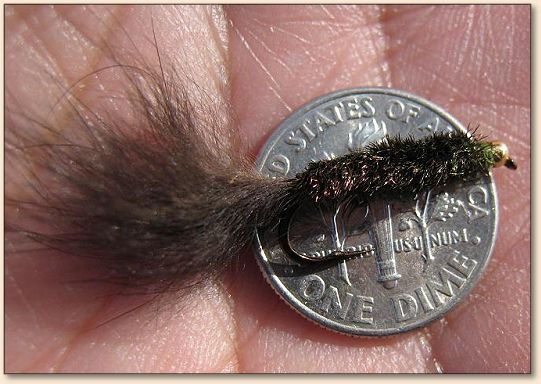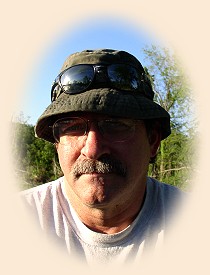|
As a rule, the fly fishing I do from my canoe is a shallow
water affair. To me this is only practical: with the lone
exception of the white crappie, the panfish group that
resides in Kansas inhabits water less than 10 feet deep
for more hours of the day, more days of the year, than it
occupies water deeper than 10 feet.
I own an electronic fish finder (a portable unit) whose
transducer shoots an ultrasonic beam that measures
15-degrees in angular width. Not every buyer of fish
finders considers the real-world implications of transducer
search beam width; I didn't before buying my unit.
One day I wanted to see a concrete representation of my
unit's search cone. Grabbing a protractor, pencil, blank
sheet of graph paper and straight edge I lined out the
maximum underwater area that my fish finder "sees" at
various water depths. The result was startling: my unit's
15-degree search cone looks at a circle of water so small
in circumference that the image appearing on my unit's LCD
screen is largely useless as a means of seeing fish in the water
beneath and around my canoe.
Electronic fish finders are fascinating instruments nevertheless,
and my drawing did nothing to diminish my appreciation for the
unit's ability to perform three important and useful tasks: 1) Tell
me how deep the water is; 2) Show me the changes in water
depth as my canoe moves about from spot to spot, and; 3) Show
me underwater objects around which fish often spend time.
I therefore rigged my canoe with my fish finder and launched
on the same 4-acre pond where recently I caught a 13-inch
black crappie – a slab that set my heart a-racing. My fish
finder quickly revealed a large area of impressive but uniform
depth – the excavation zone where enough cubic yards of soil
mass had been bulldozed to construct the pond's massive dam?
But nowhere in this flat, deepwater zone did I spot any of the
classic structures you hope for: drop-offs along creek channels,
submerged brush piles, etc. And numerous crossings of the
pond's main body detected just one cluster of "vertically stacked"
fish that may have been a school of crappies. (The fish icons
moving slowly across my display screen were so tiny they
suggested a pod of bluegills, not suspended crappies.)
After five hours I stopped trying to find fish in deep water.
Either I was missing them or they simply weren't there. That
I could tell, the deep water area was virtually deserted.
According to the landowner, white and black crappies were
stocked here initially. But I wonder if this pond no longer supports
a meaningful population of whites. It does have plenty of blacks,
though. I have a theory to explain this.
Black crappies, I've read, instinctively pursue a solitary,
stay-at-home, shallow water lifestyle that lets them thrive
in the weedy shoreline habitats typical of this and most
other Kansas farm ponds. Whereas a white crappie thrives
when it can operate as part of a school that roams large
open water areas such as those found in state and federal
lakes.
It didn't dawn on me until two days after this trip that
the only crappies I've ever caught in this pond are blacks
that took my fly fairly close to shore. I had used my fish
finder, then, in a manner better suited to locating white
crappie schools occupying deep water. My failure to
find any schools of suspended fish was not the pond's
fault, nor an indication of my fish finder's technological
failings. Rather, I was wrong in examining this pond
without taking into account the lifestyle differences
between black and white crappies. My sonar investigation
looked at water almost 20-feet deep – excellent habitat for
a kind of crappie unlike the kind I know for a fact lives in
this pond.
So my entire day was wasted pursuing a lost cause, right?
Well, not exactly. For one thing, not finding any schools of
fish in deep water lets me abandon an idea I've harbored for
quite some time; namely, that I should outfit both my anchors
with longer lines so that I can fish this pond's main area. No
more am I interested in the pond's deep water; my future
crappie-catching efforts will now target the shoreline zone.
There'll be no more nagging thoughts that I'm missing out
on something wonderful by not trying the deep water. This
is where purchasing even the least expensive electronic fish
finder is money well spent.
For another thing, while looking for suspended deep water
crappies I caught three nice bluegills that were occupying
water less than 10 feet deep. How that happened was I
repeatedly paddled or drifted across the pond's deep main
area conducting sonar passes, and upon reaching shallower
water I would anchor and fish the weedline for fifteen or
twenty minutes before searching deep water again by
crossing the pond on a different compass heading.
But during my first five hours on the pond even those
weedline areas were slow going – just three bluegills
were caught. Again this was my fault, not the pond's:
I'd arrived that morning grimly determined to find and
then catch suspended deep water crappies and I didn't
care if it took me all day to do it. With that stubborn mindset,
I stuck with fly patterns more attractive to minnow-eating
crappies than insect-eating bluegills.
So really, this trip came close to getting written up as an
object lesson in, "How empty your fish basket can be on
afternoon drives home if your brain leaves town that
morning filled with pre-conceived ideas about how the
day will turn out." Only a combination of failure, curiosity
and the generosity of an FAOL member spared me from
that sad reporting task.
Five hours of steady casting and my minnow and large
insect imitators were being ignored. Even my oldest and
most reliable #10 nymph was attracting scant attention.
The time finally came to make a radical change. Okay,
fine, but change to what? I'd spotted no surface feeding
action all day, so while cabbaging anew through my fly box
I bypassed the dry flies and poppers and looked at a row
of small furry jobs for something, anything, that might produce.
Here is where I recalled some stories I've read in the past,
stories that told how fish inhabiting relatively clear water will
sometimes prefer small, dark-colored subsurface patterns?
Using my forceps to move aside the fluffy feathers of a marabou
pattern, Renewed Hope arrived in the guise of an olive/copper-bodied,
black-tailed #12 bead-head Woolly Bugger, a fly given to me
(if memory serves) by Texas angler Stew Denton.

Dunking the bugger underwater so that I could massage
its components to squeeze out trapped air bubbles, I next
conducted a drop test to gauge how slowly the saturated
version falls. Ahh…perfect! What I would do now
is revisit some shoreline areas hit earlier, this time using much
longer countdowns so this lightweight bugger could sink very
slowly before bringing it in with ultra-slow retrieves. Maybe
the bluegills weren't hitting today, either, but there was still a
ways to go yet before they could make me believe it.
Sitting thirty feet out in 8 feet of water with my canoe anchored
so that its long axis lay parallel to the shoreline, I threw the WB
ahead and to the left into shallower water, gave the bugger a
15-second countdown and had just begun the retrieve when a
hard hit came. Many happy seconds of bent rod action later,
a thick 9-inch bluegill was unhooked and slipped into my floating
fish basket. The next two casts brought into possession two more
keeper-size 'gills.
The tide had turned. Better yet, during the ensuing flurry I saved
my 00-wt. Sage rod. Following one of my casts, I looked away
from the leader and floating line during the long countdown. My
returning gaze spotted the floating line racing away at high speed
just as the tightline shock impulse hit – perhaps the only thing that
kept that hard-running bluegill from jerking the rod out of my light
grasp. That was a little scary.
After giving up on crappie and switching to bluegills, after quitting
large patterns worked through deep water in favor of a tiny insect
imitator worked slowly through shallower water, in one hour the
little Woolly Bugger captured twelve keeper bluegills – four times
the number of fish I'd caught during the preceding five hours.
Even now, three days later, not a single thing bugs me about
that sudden late burst of good luck. ~ Joe
About Joe:
 From Douglas County, Kansas, Joe is a former municipal and
federal police officer, now retired. In addition to fishing, he hunts
upland birds and waterfowl, and for the last 15 years
has pursued the sport of solo canoeing. On the nearby
Kansas River he has now logged nearly 5,000 river miles
while doing some 400 wilderness style canoe camping
trips. A musician/singer/songwriter as well, Joe recently
retired from the U.S. General Services Adminstration.
From Douglas County, Kansas, Joe is a former municipal and
federal police officer, now retired. In addition to fishing, he hunts
upland birds and waterfowl, and for the last 15 years
has pursued the sport of solo canoeing. On the nearby
Kansas River he has now logged nearly 5,000 river miles
while doing some 400 wilderness style canoe camping
trips. A musician/singer/songwriter as well, Joe recently
retired from the U.S. General Services Adminstration.
Joe at one time was a freelance photojournalist who wrote the
Sunday Outdoors column for his city newspaper. Outdoor
sports, writing and music have never earned him any money,
but remain priceless activities essential to surviving the
former 'day job.'
|


 From Douglas County, Kansas, Joe is a former municipal and
federal police officer, now retired. In addition to fishing, he hunts
upland birds and waterfowl, and for the last 15 years
has pursued the sport of solo canoeing. On the nearby
Kansas River he has now logged nearly 5,000 river miles
while doing some 400 wilderness style canoe camping
trips. A musician/singer/songwriter as well, Joe recently
retired from the U.S. General Services Adminstration.
From Douglas County, Kansas, Joe is a former municipal and
federal police officer, now retired. In addition to fishing, he hunts
upland birds and waterfowl, and for the last 15 years
has pursued the sport of solo canoeing. On the nearby
Kansas River he has now logged nearly 5,000 river miles
while doing some 400 wilderness style canoe camping
trips. A musician/singer/songwriter as well, Joe recently
retired from the U.S. General Services Adminstration.